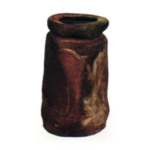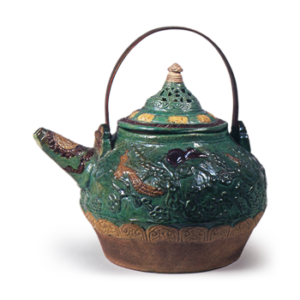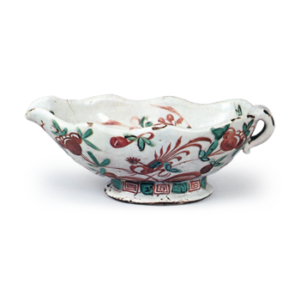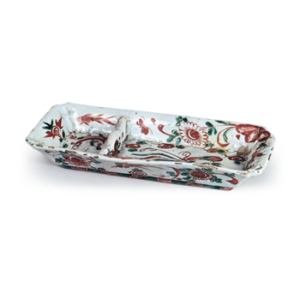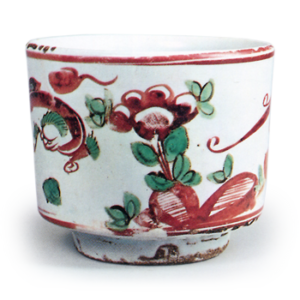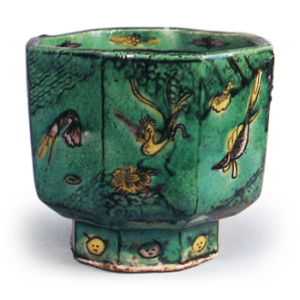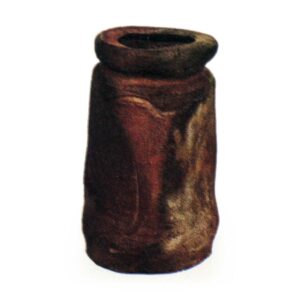
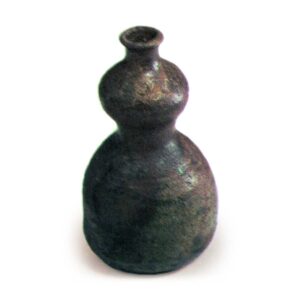
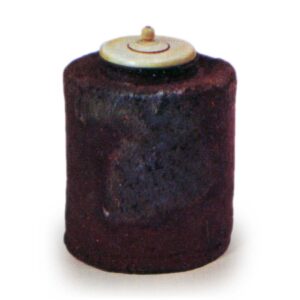
Stoneware from Bizen Province (Okayama Prefecture). It is produced in Ibe, Bizen City, and is also called “Bube-yaki” and “Inbe-yaki”, but is generally called “Bizen-yaki”.
Bizen ware was first produced in the Kamakura period (1185-1333), and the original kiln was located on the hillside of Mt. There were three kilns in Ibe at that time, the one under Mt. Kayahara was called the south kiln, the one under Mt. Furo was called the north kiln, and the one by Mt. The kilns were large, each about 35 meters long and 4.5 meters wide, and each kiln is said to have held 34,500 pieces of pottery, which were fired continuously for over 30 days using 54,500 tons of firewood. Later, vases and sake bottles were made, and in the Tensho period (1573-92), this business made great progress, producing tea pots, bowls, and ornaments for the first time. In later times, this period was referred to as Kobizen.
From the Meiwa and An’ei periods (1764-81) to the Temmei and Kansei periods (1781-1801), Bizen ceramics were at their most prosperous, producing elaborate, blue-tinged pieces known as Ao-ibe or Ao-Bizen, from Bizen’s characteristic hibo (fire stick) ware, which has a red stripe pattern on its surface as if bound, and is made entirely of unglazed white clay. In 1832 (Tempo 3), the large kiln was closed and replaced by a small kiln approximately 16 meters long and 4 meters wide, and it is said that the quality of Ibe ware declined rapidly. In the old days, Ibe ware was passed down from generation to generation by the six families of Oyoyo, Kimura, Mori, Terami, Kanashige, and Tongu, limiting the number of families to forty-six. In 1878 (Meiji Restoration), Ibe Toki Co., Ltd. was established in the same area to manufacture clay pipes exclusively, and in 1896 (Meiji 29), Bizen Toki Co. However, the so-called Bizen Pottery, which was unique to the area, declined and did not flourish.
However, the raw material of Ibe is composed of very fine molecules, and although the iron oxide content is high and the refractoriness is low, the quality of the fired product is extremely dense and hard, making it an excellent product that cannot be easily imitated in other regions. In November 1928, Kimura Heiji of the same town was ordered to prepare Ibe-yaki bottles for the grand wedding ceremony.
Kekouji Temple Chikichijiro Mimi [Products] Bizen ware belongs to the stoneware category, and its specialties range from tea pots, tea bowls, sake cups, and sliding bowls to idols and other animal figurines, many of which are huge, but current techniques are not as advanced as those of the past. Bizen ware in the olden days developed from unglazed firing and featured elegant natural scenes, but later began to use glazes, etc., and fell into a state of unattractiveness. The oldest Bizen ware still in existence today is seed pots and seed dipping jars designed to look like water jars for tea ceremonies. The mouth of a tane jar is usually wide enough to fit a fist and has two or four ears on the shoulder. If the ears are only decorative and do not have strings, the jar was made in a later period. Seed jars are larger than seed jars and have a fuller body and no ears on the shoulders. Those with ears were made in later periods, especially for tea pots. Later, around the Tensho period (1573-92), Bizen ware began to be made in the style of Nanban ware, but it was not so rigid and its tatami matting was not as refined as that of Nanban ware. Bizen ware developed under the protection of Toyotomi Hideyoshi, and there were many master craftsmen who were called “Kobizen” by later generations. Kobizen is characterized by three types of clay: purple clay with a hidasuki, pine needle burn, and enoki bark. The original burn marks on the fire are irregular and interesting, while the later artificial ones have a regular pattern and are mostly white clay. Matsuba jyoge (burnt pine needles) is also a natural pattern of irregular burnt pine needles, but the later artificial ones lack elegance. Kobizen’s Enoki-hada is rare, with a bluish-yellow color where it has been exposed to indirect fire. Ibe-te is a type of clay that has been painted and glazed with a glossy finish, and began in the late Muromachi period (1333-1568). Since the entry of the Marquis Ikeda into Japan in the Kan’ei period (1624-44), a system of “craftsmanship warrant” was established, and since then, figurative work of figures, birds, animals, etc. became popular. Since then, figurines of people, birds, animals, etc. have become popular. There are poems about the kiln marks of the Tensho period and its craftsmen, such as “I wa kooshi, Matsuba Shogen, Ding Shinbei, Maru wa Sohaku, Jyu wa Moemon.
Raw Materials: There have always been two types of clay. The other is Isonokami clay, which is mined from a field in Isonokami Village, Oku County (Isonokami, Nagafune Town), about 8 km from Ibe, and contains only a little rat-colored coarse sand.
There is no special method in the manufacturing process, and it is not different from the general manufacturing method.
(Ko-Ibe Jindenroku, Appendix of Pottery Reviews, Novels of Honcho Pottery, Ibe Toji, History of Japanese Modern Ceramics, The Complete Works of Kitamura Yaichiro, Bizen Kiln Pottery, and Taikan of Japanese Ceramics).

